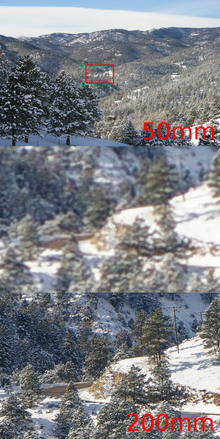Digital zoom


Digital zoom is a method of decreasing the apparent angle of view of a digital photographic or video image. Digital zoom is accomplished by cropping an image down to a centered area with the same aspect ratio as the original, and usually also interpolating the result back up to the pixel dimensions of the original. It is accomplished electronically, with no adjustment of the camera's optics, and no optical resolution is gained in the process.[1]
When comparing the image quality achieved by digital zoom with image quality achieved by resizing the image in post-processing, there's a difference between cameras that perform potentially lossy image compression like JPEG and those that save images in an always lossless Raw image format. In the former case, digital zoom tends to be superior to enlargement in post-processing, because the camera may apply its interpolation before detail is lost to compression. In the latter case, resizing in post-production yields results equal or superior to digital zoom.
Modest camera phones use only digital zoom and have no optical zoom at all. Usually cameras have an optical zoom lens, but apply digital zoom automatically once its longest optical focal length has been reached. Professional cameras generally do not feature digital zoom.
Undeteriorated (optical+digital) zoom limit
The optical zoom cameras can be set first before its maximum and then followed by its digital zoom in video mode only, but most of the cameras use the digital zoom after the optical zoom reach the maximum for photo and video. Digital zoom use the center area of the optical image to enlarge the image. By reducing the MP image size, using digital zoom can be done without image deterioration and some cameras has Undeteriorated image mode or at least has Image deterioration indicator.[2][3]
The table below give Undeteriorated (optical+digital) zoom limit for some MP image size of a certain camera with Optical zoom 24x and Digital zoom 4x for its maximum capability:
| Image Size | Maximum Zoom Factor | Undeteriorated zoom limit | Magnification of digital zoom |
|---|---|---|---|
| 16MP | 96.0x | 24.0x | 1.0x |
| 10MP | 121.2x | 30.2x | 1.3x |
| 7MP(*) | 1.5x | ||
| 5MP | 172.8x | 43.2x | 1.8x |
| 3MP | 215.5x | 54.0x | 2.25x |
| 2MP(*) | 2.8x | ||
| VGA | 382.6x | 172.8x | 7.2x |
Note: These lines are interpolation.
When using digital zoom for photo, the Undeteriorated digital zoom limit is 1.3x, 1.8x and 2.25x respectively for 10MP, 5MP and 3MP, but when using VGA, the image quality is always good under Undeteriorated digital zoom limit, because the digital zoom is only maximum 4x, while the limit is 7.2x, but some cameras with 16MP have digital zoom up to 7.2x or using the capability to the edge for VGA. The table above has also shown that from 3MP jumps directly too much too VGA and this camera has no option of 2MP (1920x1080) and 1.3MP, but other cameras have it.[4]
When using digital zoom for video, the camera can take up to 382.6x magnification in VGA with Deteriorated image quality, and up to 172.8x with Undeteriorated image quality. But because video take multiframes per second, so between Deteriorated image quality and Undeteriorated image quality will be not much different.[5]





Nowadays cameras usually have iZoom (intelligent zoom) with usually additional magnification 2x of its optical zoom, but some cameras have 2 options: 1.4x and 2.0x. The iZoom use only center of the lens and not make any interpolation to original full resolution, so it save its good images quality (optical zoom) in reduced resolution. The terms among camera manufacturers are “Smart Zoom” (Sony), “Safe Zoom” (Canon) and “Intelligent Zoom” (Panasonic and others).[6] There is also camera with digital zoom 7.2x and smartzoom with approximately 30x total zoom (optical zoom 20x and digital zoom 1.5x) for 7MP from 16MP total resolution and also 144x total zoom (optical zoom 20x and digital zoom 7.2x) for VGA 640x480.[7]
Aesthetic
Some photographers purposefully employ digital zoom for the characteristic low fidelity appearance of the images it produces. [8] This community thinks that poor quality photographs imply the carelessness of the photographer and thus, the candidness of the photograph. The notion that it is possible to achieve authenticity through pre-meditated carelessness also inspires Lo-fi music.[9]
See also
- Image scaling
- Teleside converter - a secondary lens made for fixed lenses that increases the focal length, uses as a filter
- Zoom lens
References
- ^ "Zoom Digital". Retrieved September 29, 2016.
- ^ "Casio EXILIM EX-H50 User Manual: Shooting With Zoom". Retrieved February 19, 2015.
- ^ "Casio EXILIM EX-H50 User Manual Page 43". Retrieved February 19, 2015.
- ^ "FinePix T400, T350 / T360". Retrieved April 22, 2015.
- ^ "Casio EXILIM EX-H50 User Manual Page 44". Retrieved February 19, 2015.
- ^ "Optical vs. Digital Zoom". Retrieved February 27, 2015.
- ^ "Pentax Optio VS20Hot". Retrieved June 6, 2015.
- ^ "How I Learned to Love Digital Zoom". Retrieved October 14, 2016.
- ^ "Revealing the Hollow Reality of Lo-Fi". Retrieved October 14, 2016.
